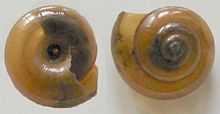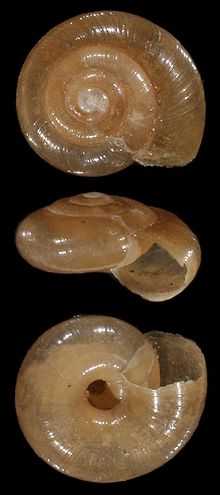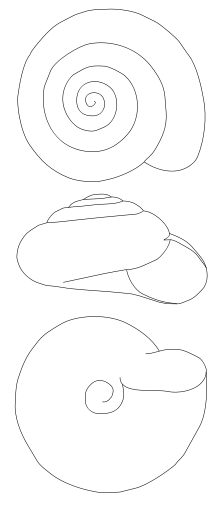Zonitoides nitidus
| Zonitoides nitidus | |
|---|---|
 | |
| Two shells of Zonitoides nitidus | |
| Conservation status | |
| NE[1] | |
| Scientific classification | |
| Kingdom: | Animalia |
| Phylum: | Mollusca |
| Class: | Gastropoda |
| (unranked): | clade Heterobranchia clade Euthyneura clade Panpulmonata clade Eupulmonata clade Stylommatophora informal group Sigmurethra clade limacoid clade |
| Superfamily: | Gastrodontoidea |
| Family: | Gastrodontidae |
| Genus: | Zonitoides |
| Subgenus: | Zonitoides |
| Species: | Z. nitidus |
| Binomial name | |
| Zonitoides nitidus (Müller, 1774)[2] | |
Zonitoides nitidus is a species of small, air-breathing land snail, a terrestrial pulmonate gastropod mollusk in the family Gastrodontidae.
Zonitoides nitidus is the type species of the genus Zonitoides.
Distribution
The distribution of Zonitoides nitidus includes the Holarctic zone. It is found almost all over Europe except the southernmost regions:[3]
- Czech Republic - least concern (LC)[4]
- Netherlands[5]
- Russia - Sverdlovsk oblast[6]
- Ukraine[7]
- Slovakia
- Great Britain - north British highland zones and not in north Scotland.[3] In some regions in Britain the species has declined due to drainage.[3]
- Ireland
- Hebrides[3]
- Orkney[3]
- Shetland[3]
- rare in northern Greece[3]
- Canada
The non-indigenous distribution of this species includes:
- introduced to Menorca[3]
Description
The shell is reddish brown.[3] The umbilicus is large (almost 25% of shell diameter).[3] The shell is with radial growth lines.[3] The width of the shell is 6–7 mm.[3] The height of the shell is 3.5-4.0 mm.[3]
The animal is black with a characteristic orange dash: the (mantle gland is visible under the shell's aperture).[3]
Juveniles are whitish grey with light brown translucent shells.[3]
 Photo of the shell. |
 Drawing of the shell. |
Ecology
Zonitoides nitidus occurs in wet meadows and river woods, usually near water bodies, swamps and swampy forests, in the zone of emergent vegetation.[3] Man-made habitats such as pools in old quarries are sometimes colonized after a few years.[3] In Switzerland it is found up to 2100m of altitude.[3]
Zonitoides nitidus is herbivorous.[3] These snails feed on disintegrating leaves, mushrooms, roots and fruit.[3] They do not eat dry leaves.[3] Humid leaves are preferred.[3] When consuming soft food such as mushrooms or soft fruits, Zonitoides nitidus penetrates perpendicularly inside, producing characteristic holes; the entire animal including its shell can penetrate inside the fruit.[3]
In Germany up to three clutches of 2-9 eggs per individual are laid in all seasons, with some days or weeks spacing between egg-laying.[3] Egg diameter is 1.0-1.6 mm.[3] Eggs are laid loose into the soil.[3] Juveniles have 1.5 whorls (diameter 1-1.2 mm) after hatching.[3] They start feeding on disintegrating plant remains in the soil.[3] After 3 months the shell diameter reaches up to 3 mm under favourable conditions, after 10 months 6 mm, and full size after slightly more than one year.[3] Maximum age is 18 months under laboratory conditions.[3]
Parasites of Zonitoides nitidus include:
References
This article incorporates public domain text from the reference.[3]
- ↑ 2006 IUCN Red List of Threatened Species. <www.iucnredlist.org>. Cited 4 March 2007.
- ↑ Müller O. F. 1774. Vermivm terrestrium et fluviatilium, seu animalium infusoriorum, helminthicorum, et testaceorum, non marinorum, succincta historia. Volumen alterum. pp. I-XXVI [= 1-36], 1-214, [1-10]. Havniæ & Lipsiæ. (Heineck & Faber).
- ↑ 3.0 3.1 3.2 3.3 3.4 3.5 3.6 3.7 3.8 3.9 3.10 3.11 3.12 3.13 3.14 3.15 3.16 3.17 3.18 3.19 3.20 3.21 3.22 3.23 3.24 3.25 3.26 3.27 3.28 3.29 3.30 "Species summary for Zonitoides nitidus". AnimalBase, last modified 29 August 2010, accessed 3 September 2010.
- ↑ Juřičková L., Horsák M. & Beran L. (2001). "Check-list of the molluscs (Mollusca) of the Czech Republic". Acta Soc. Zool. Bohem. 65: 25-40.
- ↑ http://www.anemoon.org/anm/voorlopige-kaarten/landmollusken/wetenschappelijk/zonitoides-nitidus/
- ↑ http://ecoinf.uran.ru/content/4catalog/55.shtml
- ↑ Balashov I. & Gural-Sverlova N. 2012. An annotated checklist of the terrestrial molluscs of Ukraine. Journal of Conchology. 41 (1): 91-109.
- ↑ Olsson I.-M., Stéen M. & Mann H. (1993). "Gastropod hosts of Elaphostrongylus spp. (Protostrongylidae, Nematoda)". Rangifer 13(1): 53-55. PDF.
- ↑ Michigan Department of Natural Resources and Environment. "Brainworm". accessed 14 December 2010.
External links
| Wikimedia Commons has media related to Zonitoides nitidus. |